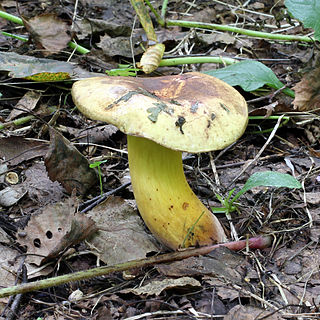Top Qs
Timeline
Chat
Perspective
Cyanoboletus pulverulentus
Species of fungus From Wikipedia, the free encyclopedia
Remove ads
Cyanoboletus pulverulentus, commonly known as the ink stain bolete, is a species of edible[2] bolete mushroom. All parts of the mushroom will stain dark bluish-black after handling.
It is found in deciduous and mixed forests, particularly on moist soil on slopes and under beech and oak trees. A common species, it is found in northern Asia, Europe, North Africa, Central and northern South America, and eastern North America.
A recent study has revealed this mushroom hyperaccumulates arsenic compounds and therefore consumption should be limited.[3]
Remove ads
Taxonomy
Boletus pulverulentus was first described by German mycologist Wilhelm Opatowski in 1836. The specific epithet pulverulentus means "covered with powder" and refers to the somewhat dry powdery surface of the young cap and stalk.[4] The fungus was transferred to the newly created genus Cyanoboletus in 2014, where it is the type species.[5] Based on the 28S rDNA, North American collection of this fungus reported in the Genbank database (accession number KF030313) does not match that from Europe.[3]
Remove ads
Description
The cap is convex, flat when old, dark reddish-brown becoming lighter with age, and grows up to 10 cm (4 in) in diameter.[6] The cap cuticle comprises a tissue layer of undifferentiated hyphae measuring 3–7 μm wide.[7]
The stalk is long and slender, bright yellow to orange yellow at the top, and reddish-brown at the base.[4] The flesh is yellow, with a mild taste and immediately turns blackish-blue when handled.[8]
The basidia (spore-bearing cells) measure 22–35 by 6–9 μm. Spores are smooth, fusoid (fuse shaped) to elliptical, and measure 11–15 by 4–6 μm.[citation needed] The spore print colour is olive brown.[9]
Similar species
The eastern North American lookalike Boletus oliveisporus can be distinguished from C. pulverulentus by the pink to reddish colour in the center section of its stipe.[2] Caloboletus, Lanmaoa, and Xerocomellus species may be similar.[9]
Remove ads
Habitat and distribution
An ectomycorrhizal species, C. pulverulentus forms associations with coniferous and deciduous trees, particularly oak. Fruit bodies appear on the ground, usually singly, in woodland. The bolete is widely distributed, having been reported from northern Asia, Europe, North Africa, Central and northern South America,[citation needed] and eastern North America (from July to September).[9] Reports of appearances in western North American could refer to the similar Cyanoboletus rainsii, which stains greenish-black instead of bluish-black.[2]
See also
References
External links
Wikiwand - on
Seamless Wikipedia browsing. On steroids.
Remove ads

